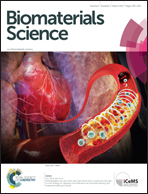Fc microparticles can modulate the physical extent and magnitude of complement activity†
Abstract
The complement system is an integral component of the humoral immune system, and describes a cascade of interacting proteins responsible for the opsonization and lysis of foreign pathogens, in addition to the recruitment of immune cells. However, complement activation is also implicated in the progression and complication of immune dysfunctions such as sepsis. Microparticle (MP) biomaterials capable of tuning the local magnitude of serum complement activation could improve complement-mediated cytotoxicity to serum-resistant bacteria or calm an overactive immune response during sepsis. We demonstrate that model Fc-functionalized microparticles can be designed to either enhance or diminish the local cytotoxic effect of complement activation in human serum. The particles were formed with either the antibody Fc domains oriented outward from the particle surface or randomly adsorbed in a non-oriented fashion. In the oriented Fc form, complement products were directly sequestered to the particle surface, including C5a, a potent anaphylatoxin that, when elevated, is associated with poor sepsis prognosis. The oriented particle also lowered the cytotoxicity of serum and thus decreased the antibiotic effect when compared to serum alone. Conversely, the non-oriented microparticles were found to sequester similar levels of C5a, but much lower levels of iC3b and TCC on the microparticle surface, thereby increasing the amount of the soluble terminal complement complex. In addition, the non-oriented microparticles extend the distance over which TCC forms and enhance serum cytotoxicity to bacteria. Together, these two types of complement-modulating particles provide the first biomaterial that can functionally modify the range of complement activation at sites distant from the particle surface. Thus, biomaterials that exploit Fc presentation provide new possibilities to functionally modulate complement activation to achieve a desired clinical result.



 Please wait while we load your content...
Please wait while we load your content...